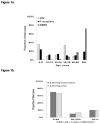Sarcomas other than Kaposi sarcoma occurring in immunodeficiency: interpretations from a systematic literature review
- PMID: 22729152
- PMCID: PMC3418441
- DOI: 10.1097/CCO.0b013e328355e115
Sarcomas other than Kaposi sarcoma occurring in immunodeficiency: interpretations from a systematic literature review
Abstract
Purpose of review: In immunodeficiency, an increased sarcoma risk is confirmed for Kaposi's sarcoma. Whether rates of other sarcoma subtypes are elevated in the setting of immunodeficiency is not known. We therefore reviewed published case reports on HIV and AIDS patients and organ transplant recipients with sarcomas. For comparison, we assessed sarcomas in the U.S. general population using Surveillance Epidemiology End Results (SEER) data.
Recent findings: A total of 176 non-Kaposi sarcoma were identified, 75 in people with HIV and AIDS and 101 in transplant recipients. Leiomyosarcomas (n = 101) were the most frequently reported sarcomas, followed by angiosarcomas (n = 23) and fibrohistiocytic tumors (n = 17). Leiomyosarcomas were reported with two age peaks, in children and young adults. Epstein-Barr virus (EBV) was detected in the tumor cells in 85 and 88% of leiomyosarcomas in HIV-infected people and transplant recipients, respectively. Angiosarcomas and fibrohistiocytic tumors were most frequently reported in men. Among kidney transplant recipients, 20% of sarcomas arose at the site of an arteriovenous fistula. In comparison, leiomyoscarcomas, angiosarcomas, and fibrohistiocytic tumors comprised 16.9, 3.8, and 18.7% of sarcomas in the U.S. general population.
Summary: Leiomyosarcoma and angiosarcoma may occur disproportionately in immunodeficiency. Leiomyosarcomas appear causatively linked to EBV, whereas angiosarcomas might be correlated with an arteriovenous fistula. Additional studies are necessary to understand the contribution of immunodeficiency to the cause of these sarcomas.
Conflict of interest statement
Disclosure: The authors have declared no conflicts of interest.
Figures

Similar articles
-
Treatment for leiomyosarcoma and leiomyoma in children with HIV infection.Cochrane Database Syst Rev. 2010 May 12;(5):CD007665. doi: 10.1002/14651858.CD007665.pub2. Cochrane Database Syst Rev. 2010. PMID: 20464756
-
Progressive resistive exercise interventions for adults living with HIV/AIDS.Cochrane Database Syst Rev. 2004 Oct 18;(4):CD004248. doi: 10.1002/14651858.CD004248.pub2. Cochrane Database Syst Rev. 2004. PMID: 15495092
-
Behavioral interventions to reduce risk for sexual transmission of HIV among men who have sex with men.Cochrane Database Syst Rev. 2008 Jul 16;(3):CD001230. doi: 10.1002/14651858.CD001230.pub2. Cochrane Database Syst Rev. 2008. PMID: 18646068
-
Aerobic exercise interventions for adults living with HIV/AIDS.Cochrane Database Syst Rev. 2005 Apr 18;(2):CD001796. doi: 10.1002/14651858.CD001796.pub2. Cochrane Database Syst Rev. 2005. Update in: Cochrane Database Syst Rev. 2010 Aug 04;(8):CD001796. doi: 10.1002/14651858.CD001796.pub3. PMID: 15846623 Updated.
-
Adefovir dipivoxil and pegylated interferon alfa-2a for the treatment of chronic hepatitis B: a systematic review and economic evaluation.Health Technol Assess. 2006 Aug;10(28):iii-iv, xi-xiv, 1-183. doi: 10.3310/hta10280. Health Technol Assess. 2006. PMID: 16904047
Cited by
-
Advanced Leiomyosarcoma of the Retroperitoneal Space in a Kidney Transplant Recipient with a History of Peritoneal Dialysis: A Case Report.Am J Case Rep. 2021 Oct 25;22:e933267. doi: 10.12659/AJCR.933267. Am J Case Rep. 2021. PMID: 34695070 Free PMC article.
-
Kidney displaced by giant retroperitoneal li-posarcoma in HIV patient.Int Braz J Urol. 2020 Jul-Aug;46(4):673-675. doi: 10.1590/S1677-5538.IBJU.2019.0515. Int Braz J Urol. 2020. PMID: 32374139 Free PMC article. No abstract available.
-
A rare case of primary breast angiosarcoma in a male: a case report.BMC Cancer. 2018 Oct 16;18(1):978. doi: 10.1186/s12885-018-4895-3. BMC Cancer. 2018. PMID: 30326852 Free PMC article.
-
Cancer Risk After Pediatric Solid Organ Transplantation.Pediatrics. 2017 May;139(5):e20163893. doi: 10.1542/peds.2016-3893. Pediatrics. 2017. PMID: 28557749 Free PMC article.
-
Epidemiology and therapies for metastatic sarcoma.Clin Epidemiol. 2013 May 16;5:147-62. doi: 10.2147/CLEP.S28390. Print 2013. Clin Epidemiol. 2013. PMID: 23700373 Free PMC article.
References
-
- Eltom MA, Jemal A, Mbuliateye SM, Devasa SS, Biggar RJ. Trends in Kaposis sarcoma and non-Hodgkin’s lymphoma incidence in the United States from 1973 through 1998. J Natl Cancer Inst. 2002;94:1204–1210. - PubMed
-
- Penn I. Sarcomas in Organ Allograft Recipients. Transplantation. 1995;60:1485–1491. - PubMed
-
- Biggar RJ, Rosenberg PS, Coté T. Kaposis sarcoma and Non Hodgkins lymphoma following the diagnosis of AIDS. Multistate AIDS Cancer Match study group. Int J Cancer. 1996;68(6):754–8. - PubMed
-
- Grulich AE, van Leeuwen MT, Falster MO, Vajdic CM. Incidence of cancers in people with HIV/AIDS compared with immunosuppressed transplant recipients: a meta-analysis. Lancet. 2007;370(9581):59–67. - PubMed
-
- Brennan MF. Soft tissue sarcoma: advances in understanding and management. Surgeon. 2005;3:216–223. - PubMed
Publication types
MeSH terms
Grants and funding
LinkOut - more resources
Full Text Sources
Medical
Research Materials

